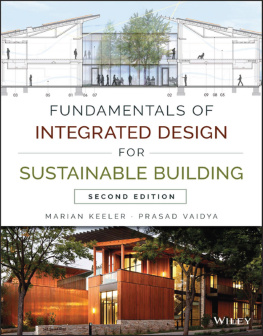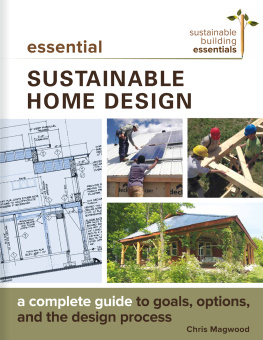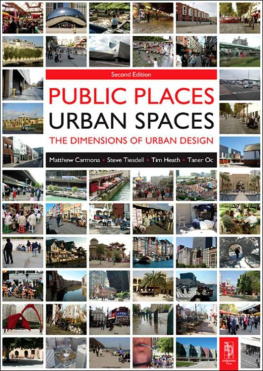
Fundamentals of Integrated Design for Sustainable Building
Second Edition
Marian Keeler
Prasad Vaidya
This book is printed on acid-free paper.
Copyright 2016 by John Wiley & Sons, Inc. All rights reserved.
Published by John Wiley & Sons, Inc., Hoboken, New Jersey.
Published simultaneously in Canada.
No part of this publication may be reproduced, stored in a retrieval system, or transmitted in any form or by any means, electronic, mechanical, photocopying, recording, scanning, or otherwise, except as permitted under Section 107 or 108 of the 1976 United States Copyright Act, without either the prior written permission of the Publisher, or authorization through payment of the appropriate per-copy fee to the Copyright Clearance Center, 222 Rosewood Drive, Danvers, MA 01923, (978) 750-8400, fax (978) 646-8600, or on the web at www.copyright.com. Requests to the Publisher for permission should be addressed to the Permissions Department, John Wiley & Sons, Inc., 111 River Street, Hoboken, NJ 07030, (201) 748-6011, fax (201) 748-6008, or online at www.wiley.com/go/permissions.
Limit of Liability/Disclaimer of Warranty: While the publisher and author have used their best efforts in preparing this book, they make no representations or warranties with the respect to the accuracy or completeness of the contents of this book and specifically disclaim any implied warranties of merchantability or fitness for a particular purpose. No warranty may be created or extended by sales representatives or written sales materials. The advice and strategies contained herein may not be suitable for your situation. You should consult with a professional where appropriate. Neither the publisher nor the author shall be liable for damages arising herefrom.
For general information about our other products and services, please contact our Customer Care Department within the United States at (800) 762-2974, outside the United States at (317) 572-3993 or fax (317) 572-4002.
Wiley publishes in a variety of print and electronic formats and by print-on-demand. Some material included with standard print versions of this book may not be included in e-books or in print-on-demand. If this book refers to media such as a CD or DVD that is not included in the version you purchased, you may download this material at http://booksupport.wiley.com. For more information about Wiley products, visit www.wiley.com.
Cover design: Wiley
Cover images: Section drawingHewlett Packard Foundation, courtesy of EHDD Architecture; Green features diagramHewlett Packard Foundation, courtesy of EHDD Architecture
Library of Congress Cataloging-in-Publication Data:
Names: Keeler, Marian, author. | Prasad Vaidya, author.
Title: Fundamentals of integrated design for sustainable building / Marian
Keeler, Prasad Vaidya.
Description: Second edition. | Hoboken : Wiley, 2016. | Includes index.
Identifiers: LCCN 2015050583 | ISBN 9781118881910 (hardback) | ISBN
9781118882276 (ebk); 9781118882399 (ebk.)
Subjects: LCSH: Sustainable architecture. | ArchitectureEnvironmental
aspects. | BISAC: ARCHITECTURE / Design, Drafting, Drawing & Presentation.
| ARCHITECTURE / Sustainability & Green Design.
Classification: LCC NA2542.36 .K44 2016 | DDC 720/.47dc23 LC record available at
http://lccn.loc.gov/2015050583
978-1-118-88191-0
We dedicate this book to our parents,
Harry and Natalie Keeler
and
Hema and Suresh Vaidya
Preface
On December 3, 2015, global representatives of the building construction industry convened the first ever Buildings Action Day as part of the Conference of the Parties United Nations Climate Change Conference, or COP21. This meeting was an open acknowledgement of the key role that buildings play both in the mounting impacts of climate change, but more important, in developing real strategies to stall, halt, and even reverse global warming. There were 70 signatories to a joint statement produced during the meeting, which included the creation of the Global Alliance for Buildings and Construction. One of the key conclusions was to invite all stakeholders along the value chain of construction to commit to solid actions within their spheres, be they governmental, institutional, commercial, academic or residential sectors. One of these greater actions is a call by the Alliance to work together to develop comprehensive action plans across the entire buildings value chain, including focus on workforce development, skills and training, support for technology transfer, and capacity building.
We believe this book is a beginning resource that will provide students with a vital tool with which to engage in this particular action plan. It will also assist in understanding the interlocking layers of sustainable building design. In design and construction, layering technologies onto a building only gets us part of the way towards high performance buildings that have low environmental impact and that provide healthy spaces for occupants. The practice of integrated building design enables us to reach further. For that, designers, builders, managers, and users need to be well versed in sustainable building issues and technologies in order to assimilate them into standard practice. The information in this book provides ways to begin doing so.
Four main topic areas transect the contents of this book: (1) the historic arc of environmentalism, green buildings ratings, certifications and policy, (2) indoor chemical pollutants and occupant health and comfort, (3) resource conservation and materials efficiency, and (4) building energy use and technologies for low-energy building design. This edition has two new chapters on energy modeling and metering and net-zero energy buildings, as well as a new chapter on climate change, health and building resilience and an expanded chapter on industrial chemistry of building materials. Because of the nature of the subject matter demands it, we treat these topics so that they are interspersed through the book.
This book is written by practitioners. It is the result of research done for real projects, with experience gained in the field. Rather than providing descriptions on a few selected strategies, we bring you essentials on what matters most in the hierarchy of sustainable design. For that which we can cover as introductory material, we suggest resources and exercises for additional study. As you read and study, you will conclude that among the numerous environmental issues that sustainable design responds to, climate change impacts are among the most prominent. Impacts are being felt that make the need for solutions urgent and a certain degree of activism is required in order to change the course. Paul Hawken postulates that we can and should harnesses this action to find impactful, substantive solutions to climate change and create what is known as drawdown. Drawdown, as described by Hawken, is the point at which greenhouse gases in the atmosphere begin to decline on a year-to-year basis. The technical, social and ecological solutions that Hawken and his organization have brainstormed embrace issues such as land management, agriculture, reforestation, but many have direct relationships with building design and urban planning. As of press time, these newer cutting-edge solutions to integrated design tracks are also being discussed by colleagues Janine Benyus of Biomimicry 3.8, sustainable design leaders at Google, healthcare expert Gail Vittori and sustainable structural design engineer, Frances Yang of Arup. A great deal of overlap lies in their focus on low-carbon construction. We are called on to:
Next page







